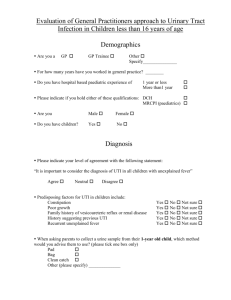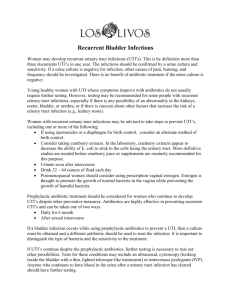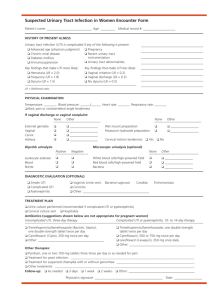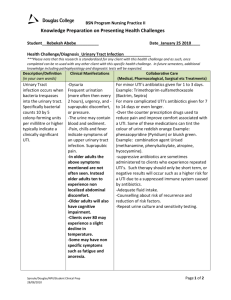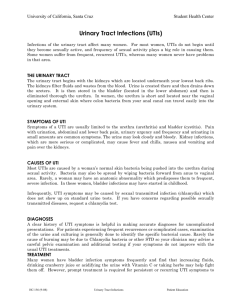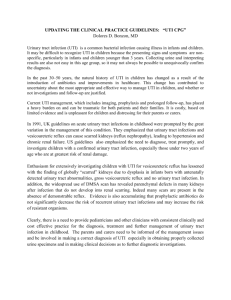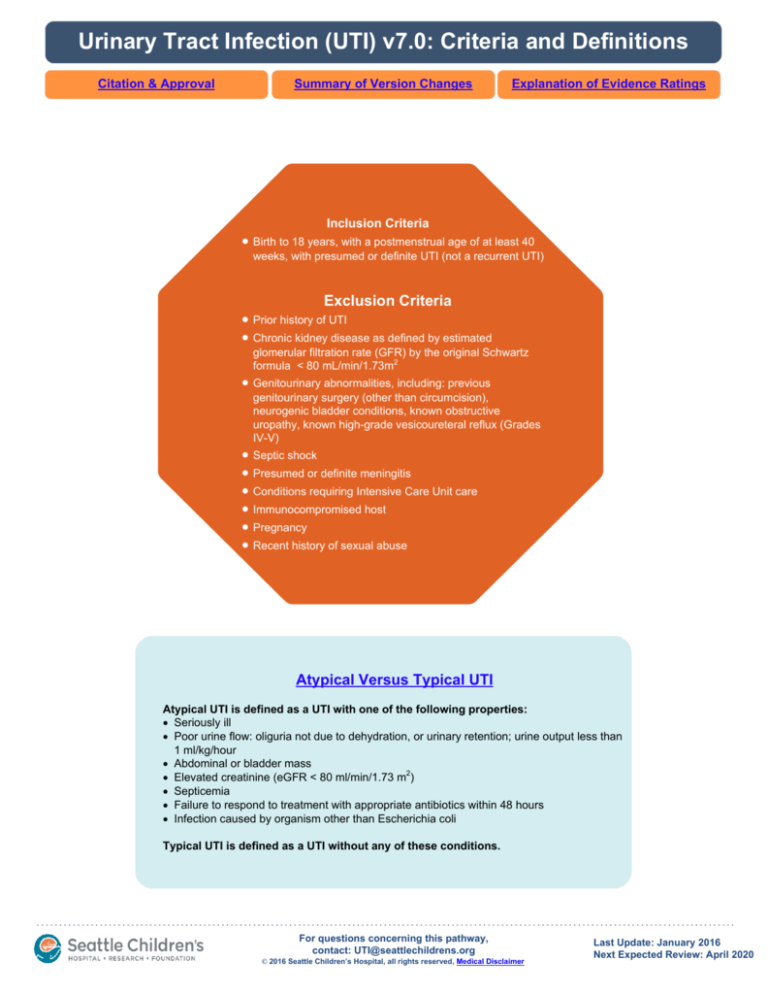
Urinary Tract Infection (UTI) v7.0: Criteria and Definitions
Citation & Approval
Summary of Version Changes
Explanation of Evidence Ratings
Inclusion Criteria
· Birth to 18 years, with a postmenstrual age of at least 40
weeks, with presumed or definite UTI (not a recurrent UTI)
Exclusion Criteria
· Prior history of UTI
· Chronic kidney disease as defined by estimated
·
glomerular filtration rate (GFR) by the original Schwartz
formula < 80 mL/min/1.73m2
Genitourinary abnormalities, including: previous
genitourinary surgery (other than circumcision),
neurogenic bladder conditions, known obstructive
uropathy, known high-grade vesicoureteral reflux (Grades
IV-V)
Septic shock
·
· Presumed or definite meningitis
· Conditions requiring Intensive Care Unit care
· Immunocompromised host
· Pregnancy
· Recent history of sexual abuse
Atypical Versus Typical UTI
Atypical UTI is defined as a UTI with one of the following properties:
· Seriously ill
· Poor urine flow: oliguria not due to dehydration, or urinary retention; urine output less than
1 ml/kg/hour
· Abdominal or bladder mass
· Elevated creatinine (eGFR < 80 ml/min/1.73 m2)
· Septicemia
· Failure to respond to treatment with appropriate antibiotics within 48 hours
· Infection caused by organism other than Escherichia coli
Typical UTI is defined as a UTI without any of these conditions.
For questions concerning this pathway,
contact: UTI@seattlechildrens.org
© 2016 Seattle Children’s Hospital, all rights reserved, Medical Disclaimer
Last Update: January 2016
Next Expected Review: April 2020
Urinary Tract Infection v7.0: Diagnosis
Decision to Test:
Infants
· Febrile or prolonged jaundice
· > 8 days of age: irritable, emesis,
failure to thrive
Decision to Test:
Toilet Trained Children &
Adolescents
Decision to Test:
Non-Toilet Trained Children
· Girl or uncircumcised boy: need ≥ 1 of
the following.
· Circumcised boy: need ≥ 2 of the
following OR suprapubic tenderness
alone.
Ill appearing, suprapubic tenderness,
fever > 24 hrs, fever > 39ºC,
fever without source
· Girl or uncircumcised boy: need ≥
1 of the following.
· Circumcised boy: need ≥ 2 of the
following.
Abdominal pain, back pain, dysuria,
frequency, new-onset incontinence,
fever > 40ºC (particularly if no source)
Decision to test criteria met
Obtain Urinalysis and Urine Culture
by the Following Method(s)
!
Test of cure
urine cultures
not recommended
· Infants: Catheterization or suprapubic aspiration
(SPA)
(SPA)
· Non-Toilet Trained Children: 2-6 months:
consider SPA; otherwise catheterized
· Toilet Trained Children: Midstream clean catch
· Adolescents: Midstream clean catch + ‘dirty’
urine for Gonococcus (GC)/Chlamydia(Chl)
If an adolescent,
also obtain
If an infant,
also obtain
Additional Studies:
Infants
!
Potential poor
sensitivity of
U/As in infants
Additional Studies:
Adolescents
If non-toilet trained,
also obtain
If toilet trained,
also obtain
· 0-60 days of age: refer to
Neonatal Fever Pathway
Additional Studies:
Toilet Trained
Additional Studies:
Non-Toilet Trained
· If ill appearing, consider blood
culture and CSF studies
· HSV testing: Culture visible lesions,
or cervical culture as indicated.
· If GC/Chl positive: Consider
Syphilis Screen
· Annual HIV testing
· Consider pregnancy testing in girls
· If ill appearing, consider blood
culture
Return to Home
For questions concerning this pathway,
contact: UTI@seattlechildrens.org
© 2016 Seattle Children’s Hospital, all rights reserved, Medical Disclaimer
Last Update: January 2016
Next Expected Review: April 2020
Urinary Tract Infection v7.0: Outpatient Management
Admit Criteria
All Age Categories
· Toxic appearance
· Dehydration requiring IV fluids
· Adherence risk as defined by: unable to take previously prescribed regimen,
no reliable caregivers at home, inability to follow recommended care plan, or
at risk for loss to follow-up
· Failed outpatient therapy as defined by: persistent clinical symptoms beyond
48 hours on appropriate therapy, or inability to maintain hydration status
Infants
· Admit all patients up to 30 days of age with presumed or definite UTI
· Admit all febrile patients 31-60 days of age with presumed or definite UTI
Adolescents
· Adherence risk is not an admission criteria for adolescents with cystitis
!
Consider
further imaging
if no improvement
in 48 hrs
No,
begin outpatient
management for
presumed UTI
Outpatient Management:
Nonfebrile Infants
(31-60 days)
· Give ceftriaxone IM OR
cephalexin PO
· Follow up with primary care
provider within 24 hours
Patient meets admit
criteria?
Outpatient Management:
Non-Toilet Trained Children,
Toilet Trained Children &
Adolescents
· Give cephalexin PO, OR
trimethoprim/sulfamethoxazole PO
(if cephalosporin allergy) OR
ceftriaxone IM
Yes,
begin inpatient
management for
presumed UTI
!
Criteria for
Urology Referral
Phase Change
Culture results follow-up
· Call family to review culture
results
· Narrow coverage when
sensitivities return
For questions concerning this pathway,
contact: UTI@seattlechildrens.org
© 2016 Seattle Children’s Hospital, all rights reserved, Medical Disclaimer
Return to Home
Last Update: September 2016
Next Expected Review: April 2020
Urinary Tract Infection v7.0: Inpatient Management
Inpatient Management:
Infants (0-30 days)
· Give IV ampicillin +
gentamicin OR ampicillin +
cefotaxime
· Give IV antibiotics 7 days
minimum, then 7 days PO; 14
days total
· Switch to PO at 7 days if
responding and after
identification and sensitivities
return; narrow coverage if
possible
· Give IV ceftriaxone OR ampicillin +
gentamicin if cocci/enterococcus is
suspected
· Give IV antibiotics until afebrile X 24 hrs
(minimum 36 hours IV with negative
initial blood cultures)
· Switch to PO if responding after
identification and sensitivities return;
narrow coverage if possible
· Total duration of antibiotics: 14 days
· Give IV ceftriaxone OR ampicillin +
gentamicin if cocci/enterococcus is
suspected
· Switch to PO if responding after
identification and sensitivities return;
narrow coverage if possible
· Total duration of antibiotics: adolescents
(7 days), toilet trained (7-14 days), nontoilet trained (10-14 days), adolescent
with cystitis (3 days)
Positive blood culture?
Positive blood
culture?
Positive Blood Culture v
Positive Blood Culture
· If Bacteremic, continue
management as above
Inpatient Management:
Non-Toilet Trained Children, Toilet
Trained Children & Adolescents
Inpatient Management:
Infants (31-60 days)
v
· If Bacteremic, give 7 days IV + 7 days PO
· May consider early transition if:
· clinically back to baseline
· afebrile x 24hrs
· repeat blood culture negative x 48hrs
· good oral option available
· Consider ID consult in cases of atypical UTI,
early transition to orals in children 1-6 months
old, or any other ID related questions
Evaluate for
discharge
Evaluate for discharge
!
Consider
imaging if no
improvement in
48 hrs
Evaluate for discharge
Discharge Criteria
!
Criteria for
Urology Referral
General discharge criteria for all patients
· Clinical response to therapy
· Able to maintain hydration status
· Social risk factors assessed and addressed
· Family education provided/completed
· Urine culture is negative on final report OR urine culture is positive and patient
is on targeted antibiotics
· Other studies for bacteremia and meningitis are negative (if applicable), or if
bacteremic have completed appropriate course of IV antibiotic therapy
· If indicated, renal ultrasound completed or pre-natal ultrasound reviewed
· If indicated, VCUG completed or scheduled
· Consultation (e.g., urology, nephrology, ID) completed if desired
Infants: General criteria and
· Afebrile (T < 38C) for 24 hours
· Tolerating planned home therapy
Non-toilet trained and toilet trained children
· Afebrile (T < 38C) for 12 hours
Adolescents
· Completion of or plan for additional sexually transmitted infection (STI) testing
as indicated
For questions concerning this pathway,
contact: UTI@seattlechildrens.org
© 2016 Seattle Children’s Hospital, all rights reserved, Medical Disclaimer
Return to Home
Last Update: January 2016
Next Expected Review: April 2020
Urinary Tract Infection v7.0: Imaging Recommendations
Age Category?
Infant
or non-toilet trained
Toilet-trained
or adolescent
Imaging Recommendations:
Infants and Non-toilet Trained Children
Imaging Recommendations:
Toilet-trained Children and Adolescents
Renal Ultrasound (RUS)
· Can skip RUS if high quality third trimester U/S is normal
and < 1 month of age
· If stones are present, refer to Nephrolithiasis Pathway
Renal Ultrasound (RUS)
· For boys with first UTI, or girls with atypical UTI
· If stones are present, refer to Nephrolithiasis Pathway
VCUG if
VCUG if
· Atypical UTI (seriously ill, poor urine flow (< 1 ml/kg/hr),
mass, increased creatinine (eGFR < 80), treatment failure,
non-E. coli) OR
· RUS shows: hydronephrosis (pelvocaliectasis), renal
parenchymal loss, kidney size discrepancies independent
of SFU grade
· Atypical UTI (seriously ill, poor urine flow (< 1 ml/kg/hr),
mass, increased creatinine (eGFR < 80), treatment
failure, non-E. coli) OR
· RUS shows: hydronephrosis (pelvocaliectasis), renal
parenchymal loss, kidney size discrepancies
independent of SFU grade
VCUG recommended when patient is stable, >24 hours
afebrile, and prior to the end of antibiotic therapy if possible
VCUG recommended when patient is stable, >24 hours
afebrile, and prior to the end of antibiotic therapy if possible
!
Antibiotic
prophylaxis
not routinely
recommended for
Gr I-III vesicoureteral reflux
!
Give antibiotic
prophylaxis prior
to VCUG
Return to Home
For questions concerning this pathway,
contact: UTI@seattlechildrens.org
© 2016 Seattle Children’s Hospital, all rights reserved, Medical Disclaimer
Last Update: January 2016
Next Expected Review: April 2020
Return to Diagnosis
Return to Home
Return to Outpatient
Management
Sensitivity of U/As in Infants
Return to Diagnosis
Diagnosis: Definite UTI
Culture results defining a definite UTI are:
• Single predominant organism (one organism meets criteria below, all other
organisms do not meet criteria below) (, Seattle Children's UTI
Pathway 2011)
o
≥ 100,000 colony forming units (CFU)/ml for clean catch
o
≥ 50,000 CFU/ml for in- and out- catheterization and suprapubic aspiration
Return to Diagnosis
Return to Diagnosis
Return to Diagnosis
To Antibiotic
Stewardship Pg 2
Return to Outpatient
Management
Return to Outpatient
Management
To Antibiotic
Stewardship Pg 3
Return to Outpatient
Management
Return to Inpatient
Management
Return to Inpatient
Management
Return to Inpatient
Management
Return to Outpatient
Management
Return to Outpatient
Management
Return to Inpatient
Management
Return to Diagnosis
To VCUG
Return to Imaging
Back to RUS
Return to Imaging
Procalcitonin
Back to RUS
Return to Imaging
Return to Imaging
Return to Outpatient
Management
Return to Inpatient
Management
Return to Imaging
Return to Imaging
Value Analysis: Positive Blood Cultures
DIMENSION
CARE OPTION A
DESCRIPTION OF CARE TREATMENT OPTION
CARE OPTION B
All children with
bacteremia receive
minimum 7 days IV
antibiotics
Children with bacteremia
can transition early from
IV to PO based on clinical
criteria
90%
100.00%
PREFERRED OPTION
ASSUMPTIONS MADE
OPERATIONAL FACTORS
Percent adherence to care (goal 80%)
OPTION B
maintaining IV access for 7 days is problematic; may need
OPTION
restarts
B
Care delivery team effects
BENEFITS / HARMS (QUALITY/OUTCOME)
NEUTRAL
Degree of recovery at discharge
assumes that IV and oral are equivalen
NEUTRAL
Effects on natural history of the disease over equivalent time
prolonged hospitalization,risk
multiple
of lessIVadherence
starts
if sent
UNKNOWN
home early
Potential to cause harm
OPTION B
Palatability to patient/family
N/A
Population-related benefits
Threshold for population-related benefits reached
COST (Arising from Options A or B) - express as cost per day
“ROOM RATE” ($ or time to recovery)
$6,000 (additional 3 days) No additional cost
OPTION B LESS EXPENSIVE
$38/day x 3 additional days$29/day
of IV abx
for 3 additional days
OPTION
of PO B LESS EXPENSIVE
“Dx/Rx” costs ($)
COST (Complications/adverse effects arising from Options A or B)- express as cost per day
NEUTRAL
“ROOM RATE” ($ or time to recovery)
IV infiltratings and IV lost
OPTION B LESS EXPENSIVE
“Dx/Rx” costs ($)
STEP 3: APPLY VALUE ANALYSIS GRID
BENEFIT (QUALITY & OUTCOMES)
COST
A>B
A=B
A<B
Unclear
A costs more than B
Make value judgement
B
B
Do B and PDSA in 1 year
A and B costs are the same
A
A or B, operational
factors may influence
choice
B
B costs more than A
A
A
Make value judgement
A or B, operational
factors may influence
choice, PDSA in 1 year
Do A and PDSA in 1 year
STEP 4: MAKE CSW VALUE JUDGEMENT
FINAL CSW VALUE STATEMENT
Due to the uncertainty surrounding the difference between Option A and B to produce harm, the
committee did not feel that it could provide a strong recommendation to change current practice in favor
of Option B. Consensus was reached between the committee, Hospital Medicine and Infectious Diseases
to maintain current state but to provide guidance on when it would be appropriate to consider early
tranistion to PO therapy (afebrile for 24hrs, repeat blood culture negative for 48hrs and good oral option
available). The committee will review local outcomes data in 1 year to determine if there is enough data to
inform the potential to cause harm variable.
Return to Inpatient Phase
Urinary Tract Infection (UTI) Approval & Citation
Approved by the CSW Urinary Tract Infection (UTI) for April 8, 2015
CSW UTI Team:
Hospital Medicine, Owner
Emergency Medicine, Owner
Emergency Medicine, CNS
Hospital Medicine, CNS
Radiology
Urology
Rebecca Taxier, MD
Derya Caglar, MD
Sara Fenstermacher, RN
Kristi Klee, MSN, RN-BC
Randy Otto, MD
Richard Grady, MD
Clinical Effectiveness Team:
Consultant:
Project Leader
KM Analyst:
CIS Informatician:
CIS Analyst:
Librarian:
Program Coordinator:
Claudia Crowell, MD
Elizabeth Austin, MPH
Susan Stanford, MPH, MSW
Michael Leu, MD, MS, MHS
Heather Marshall
Susan Klawansky, MLS
Ashlea Tade
Executive Approval:
Sr. VP, Chief Medical Officer
Sr. VP, Chief Nursing Officer
Surgeon-in-Chief
Mark Del Beccaro, MD
Madlyn Murrey, RN, MN
Bob Sawin, MD
Retrieval Website: http://www.seattlechildrens.org/pdf/UTI-pathway.pdf
Example:
Seattle Children’s Hospital, Taxier R, Austin E, Caglar D, Crowell C, Fenstermacher S, Grady R,
Klee K, Leu MG, Otto R, Rooholamini S. 2015 April. Urinary Tract Infections (UTI) Pathway.
Available from: http://www.seattlechildrens.org/pdf/UTI-pathway.pdf
Return to Home
Evidence Ratings
This pathway was developed through local consensus based on published evidence and expert
opinion as part of Clinical Standard Work at Seattle Children’s. Pathway teams include
representatives from Medical, Subspecialty, and/or Surgical Services, Nursing, Pharmacy, Clinical
Effectiveness, and other services as appropriate.
When possible, we used the GRADE method of rating evidence quality. Evidence is first assessed
as to whether it is from randomized trial or cohort studies. The rating is then adjusted in the
following manner (from: Guyatt G et al. J Clin Epidemiol. 2011;4:383-94.):
Quality ratings are downgraded if studies:
· Have serious limitations
· Have inconsistent results
· If evidence does not directly address clinical questions
· If estimates are imprecise OR
· If it is felt that there is substantial publication bias
Quality ratings are upgraded if it is felt that:
· The effect size is large
· If studies are designed in a way that confounding would
likely underreport the magnitude of the effect OR
· If a dose-response gradient is evident
Guideline – Recommendation is from a published guideline that used methodology deemed
acceptable by the team.
Expert Opinion – Our expert opinion is based on available evidence that does not meet GRADE
criteria (for example, case-control studies).
Note about periodic reviews: The CSW team conducts a full literature search for pathways every
3-5 years, reviewing literature since the previous pathway version and updating all
recommendations with new evidence as applicable. The evidence ratings shown on pathway
pages represent literature graded across pathway iterations:
· If the newer evidence is higher than the previous, the grade reflects the new evidence.
·
·
·
If the evidence level is the same as the previous pathway iteration, the grade remains the
same (representing a combination of old and new literature).
If the evidence level is lower in the new literature, both the new literature and the old
pathway may be cited (graded separately).
If there is no new evidence, the previous pathway evidence and grade are cited.
Return to Home
To Bibliography, Pg.1
Summary of Version Changes
Version 2 (12/03/2011): Expanded recommendation for empiric outpatient antibiotics to include oral
cephalexin or oral cefuroxime
Version 2.3 (4/3/2013): Removed race from the decision to treat parameter; included information on
timing of obtaining a VCUG; expanded discussion about cephalexin still being first-line treatment for
E. coli in UTI
Version 3.0 (6/3/2014): Added additional content/information regarding the VCUG and SFU grade
with a link to the SFU grade training slide
Version 4.0 (4/8/2015): Periodic review, full literature search completed, multiple changes made to
algorithm and power plan
Version 4.1 (7/6/2015): Formatting updates to bibliography
Version 5.0 (9/29/15): Updated inclusion/exclusion criteria to coincide with Nephrolithiasis pathway
go live. Addition to imaging section specifically renal ultrasound to consider Nephrolithiasis pathway
if stones are present.
Version 6.0 (1/20/16): CSW value analysis performed including review of positive blood culture
recommendation.
Version 7.0 (2/26/2016): Updated thresholds for positive urine cultures to better align with most
recent AAP Guidelines.
Return to Home
Medical Disclaimer
Medicine is an ever-changing science. As new research and clinical experience broaden our
knowledge, changes in treatment and drug therapy are required.
The authors have checked with sources believed to be reliable in their efforts to provide
information that is complete and generally in accord with the standards accepted at the time of
publication.
However, in view of the possibility of human error or changes in medical sciences, neither the
authors nor Seattle Children’s Healthcare System nor any other party who has been involved in
the preparation or publication of this work warrants that the information contained herein is in
every respect accurate or complete, and they are not responsible for any errors or omissions or
for the results obtained from the use of such information.
Readers should confirm the information contained herein with other sources and are
encouraged to consult with their health care provider before making any health care decision.
Return to Home
Bibliography
Literature Search
Literature Search Strategy
Search Methods, Urinary Tract Infection (UTI), Clinical Standard Work
Studies were identified by searching electronic databases using search strategies developed
and executed by a medical librarian, Susan Klawansky.. Searches were performed in May and
October, 2014. The May 2014 search was performed in the following databases: on the Ovid
platform – Medline (July 2010 to date), Cochrane Database of Systematic Reviews (2010 to
date); elsewhere – Embase (July 2010 to date), Clinical Evidence, National Guideline
Clearinghouse and TRIP (all 2010 to date). Retrieval was limited to English language and ages
0-18, except for the question relating to VCUG, which was limited to infants ages 0-2. In
Medline and Embase, appropriate Medical Subject Headings (MeSH) and Emtree headings
were used respectively, along with text words, and the search strategy was adapted for other
databases using textwords alone. Concepts searched were urinary tract infection,
pyelonephritis, cystitis, bacteriuria, pyuria and vesico-ureteral reflux/VCUG. All retrieval was
further limited to certain evidence categories such as relevant publication types, Clinical Queries,
index terms for study types and other similar limits.
An additional search was conducted in October 2014 in the following databases: on the Ovid
platform – Medline and Central Register of Controlled Clinical Trials; elsewhere – Embase. All
were searched from 2010 to current, results limited to English and ages 0-18. Search strategies
were constructed as above, using index terminology and textwords as appropriate. Concepts
searched were anti-bacterial agents, drug administration routes, intravenous injections or
infusions, oral administration, drug administration schedule, bacteremia and blood culture –
searched independently of urinary tract infections. All retrieval was further limited to certain
evidence categories such as relevant publication types, Clinical Queries, index terms for study
types and other similar limits.
Additional articles were identified by team members and added to results.
Return to Home
To Bibliography, Pg 2
Bibliography
Identification (Question 1-4)
485 records identified
through database searching
2 additional records identified
through other sources
Screening
439 records after duplicates removed
439 records screened
Eligibility
33 records assessed for eligibility
406 records excluded
18 full-text articles excluded,
2 did not answer clinical question
9 did not meet quality threshold
7 outdated relative to other included study
Included
15 studies included in pathway
Flow diagram adapted from Moher D et al. BMJ
2009;339:bmj.b2535
Identification (Question 5)
192 records identified
through database searching
4 additional records identified
through other sources
Screening
196 records after duplicates removed
196 records screened
192 records excluded
Eligibility
4 records assessed for eligibility
0 full-text articles excluded
Included
To Bibliography,4 Pg
2
studies
included in pathway Return to Home
Flow diagram adapted from Moher D et al. BMJ
2009;339:bmj.b2535
To Bibliography, Pg 1
To Bibliography, Pg 3
Bibliography
1. Urinary tract infection in children. https://arms.evidence.nhs.uk/resources/hub/1029882/attachment;. Updated
2013.
2. Clinical Practice Guideline for Urinary Tract Infection in Children. http://www.guiasalud.es/GPC/
GPC_483_ITU_poblacion_pediatrica_ICS_ing.pdf. Updated 2011.
3. AAP Subcommittee on Urinary Tract Infection of the Council on Quality Improvement and Patient Safety. 2011
AAP UTI guideline reaffirmed after review of new data. AAP News. 2014;35(7):1-1.
4. Bocquet N, Sergent Alaoui A, Jais JP, et al. Randomized trial of oral versus sequential IV/oral antibiotic for
acute pyelonephritis in children. Pediatrics. 2012;129(2):e269-75. Accessed 20120203; 10/25/2013 2:46:15 PM.
http://dx.doi.org/10.1542/peds.2011-0814.
5. Brady PW, Conway PH, Goudie A. Length of intravenous antibiotic therapy and treatment failure in infants with
urinary tract infections. Pediatrics. 2010;126(2):196–203.
6. Finnell SM, Carroll AE, Downs SM, Subcommittee on Urinary Tract I. Technical report-diagnosis and
management of an initial UTI in febrile infants and young children. Pediatrics. 2011;128(3):e749-70. Accessed
20120222; 10/25/2013 2:46:15 PM. http://dx.doi.org/10.1542/peds.2011-1332.
7. Fitzgerald A, Mori R, Lakhanpaul M, Tullus K. Antibiotics for treating lower urinary tract infection in children.
Cochrane Database of Systematic Reviews [scheduled]. 2012;8.
8. Hoberman A, Wald ER, Hickey RW, et al. Oral versus initial intravenous therapy for urinary tract infections in
young febrile children. Pediatrics. 1999;104(1 pt 1):79–86.
9. La Scola C, De Mutiis C, Hewitt IK, et al. Different guidelines for imaging after first UTI in febrile infants: Yield,
cost, and radiation. Pediatrics. 2013;131(3):e665-71. Accessed 20130304; 10/25/2013 2:46:15 PM. http://
dx.doi.org/10.1542/peds.2012-0164.
10. Leroy S, Fernandez-Lopez A, Nikfar R, et al. Association of procalcitonin with acute pyelonephritis and renal
scars in pediatric UTI. Pediatrics. 2013;131(5):870-879. Accessed 20130502; 10/25/2013 2:46:15 PM. http://
dx.doi.org/10.1542/peds.2012-2408.
11. Leroy S, Romanello C, Galetto-Lacour A, et al. Procalcitonin is a predictor for high-grade vesicoureteral reflux
in children: Meta-analysis of individual patient data. J Pediatr [scheduled]. 2011;159(4):644-51.e4. Accessed
20110919; 5/2/2014 2:10:52 PM. http://dx.doi.org/10.1016/j.jpeds.2011.03.008.
12. Mantadakis E, Vouloumanou EK, Georgantzi GG, Tsalkidis A, Chatzimichael A, Falagas ME. Acute tc-99m
DMSA scan for identifying dilating vesicoureteral reflux in children: A meta-analysis. Pediatrics [scheduled].
2011;128(1):e169-79. Accessed 20110704; 5/2/2014 2:10:52 PM. http://dx.doi.org/10.1542/peds.2010-3460.
13. Michael M, Hodson EM, Craig JC, Martin S, Moyer VA. Short versus standard duration oral antibiotic therapy
for acute urinary tract infection in children. Cochrane Database of Systematic Reviews [scheduled]. 2010;5.
14. Roman HK, Chang PW, Schroeder AR. Diagnosis and management of bacteremic urinary tract infection in
infants. Hosp Pediatr [UTI]. 2015;5(1):1-8.
15. RIVUR Trial I, Hoberman A, Greenfield SP, et al. Antimicrobial prophylaxis for children with vesicoureteral
reflux. N Engl J Med. 2014;370(25):2367-2376. Accessed 20140619. http://dx.doi.org/10.1056/NEJMoa1401811.
To Bibliography, Pg 2
To Bibliography, Pg 4
Bibliography
16. Schroeder AR, Ralston SL. Intravenous Antibiotic Durations for Common Bacterial Infections in Children:
When is Enough Enough? Journal of Hospital Medicine. 2014;9:604–609.
17. Seattle Children’s Hospital, Leu MG, Beardsley E, Drummond K, Klee K, Migita D, Popalisky J, Tieder J.
2011 December. Urinary Tract Infections (UTI) Pathway.
18. Shaikh N, Ewing AL, Bhatnagar S, Hoberman A. Risk of renal scarring in children with a first urinary tract
infection: A systematic review. Pediatrics [scheduled]. 2010;126(6):1084-1091. Accessed 20101202; 5/2/2014
2:10:52 PM. http://dx.doi.org/10.1542/peds.2010-0685.
19. Subcommittee on Urinary Tract Infection, Steering Committee on Quality Improvement and Management.
Roberts KB. Urinary tract infection: Clinical practice guideline for the diagnosis and management of the initial
UTI in febrile infants and children 2 to 24 months. Pediatrics. 2011;128(3):595-610. Accessed 20120222; 10/
25/2013 2:46:15 PM. http://dx.doi.org/10.1542/peds.2011-1330.
20. Tekgul S, Riedmiller H, Dogan HS, Hoebeke P, Kocvara R, Nijman R, Radmayr C, Stein R. Guidelines on
paediatric urology. Arnhem, The Netherlands: European Association of Urology, European Society for
Paediatric Urology; 2013 Mar. 126 p.
Link to Appendix for original Bibliography
To Bibliography, Pg 3
Return to Home


